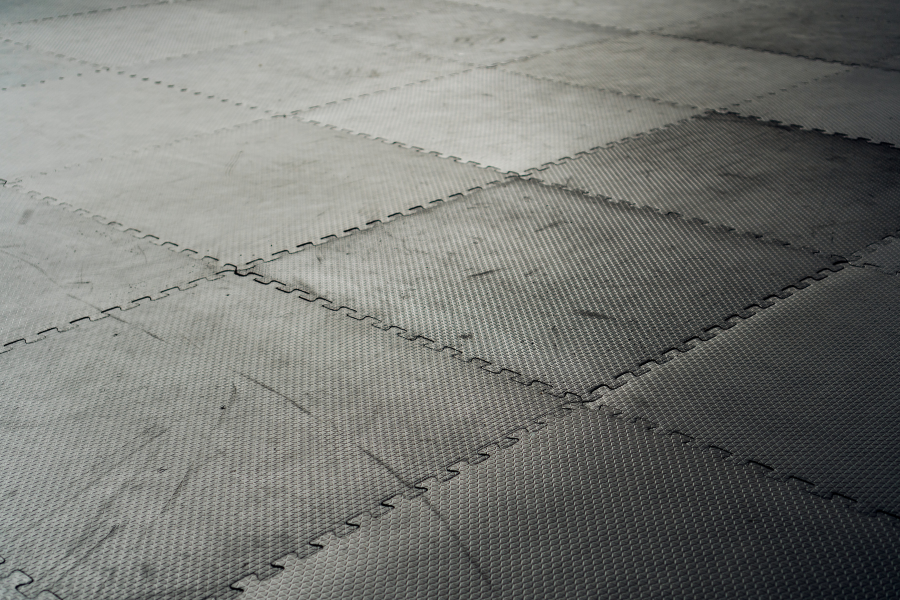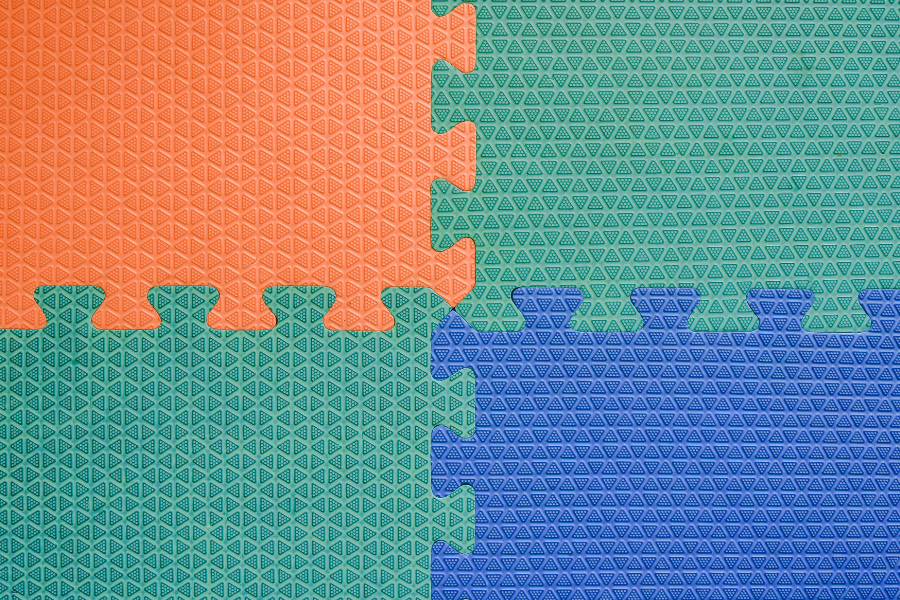Get ready to find the perfect gym flooring solution that suits your needs and preferences! When it comes to rolls or interlocking tiles for your gym, there are pros and cons to consider. Let’s dive into the world of gym flooring options and explore which one is the ideal fit for you. Prepare to create the foundation for your workouts that not only meets your requirements but also adds a touch of style to your fitness space. It’s time to pick a floor that will elevate your gym experience to new heights!
Gym flooring rolls are generally a better choice because they offer a seamless surface, durability, and easier cleaning. They are cheaper for large areas but are a bit more difficult to install. Puzzle gym tiles are easy to install, and versatile but have many seams which make them harder to clean.
When it comes to choosing between gym flooring rolls or interlocking tiles, it’s essential to weigh the pros and cons of each option. In this exploration of gym flooring options, we’ll delve into the ideal fit for your fitness space, ensuring that your chosen floor not only meets your requirements but also adds a touch of style to elevate your gym experience.
Contents
Are Rolls Or Interlocking Tiles Better For Gym Flooring?
In general, gym flooring rolls or workout mats are a better choice than interlocking tiles for home gyms. Rolls provide a seamless surface which makes for a cleaner look, a more durable, and safer surface that’s also easier to clean.
Gym mats are a bit harder to install since they’re large and heavy but once they’re in place, they are more durable and look better than tiles.
Gym mats are also slightly cheaper if used in larger areas. Rolls are available in sizes as small as 4’x4’ although commonly as 4’x6’. That’s usually the minimum size you need gym flooring in anyways but if you need less gym flooring than that, tiles will be cheaper since you can often buy only a few tiles.
Interlocking puzzle tiles are easier to install and remove but are generally a little less durable and don’t create a smooth, seamless surface. This can cause tripping hazards and makes it more difficult to clean the surface. All the seams let water and dirt through where rolls are pretty much waterproof.
If a single tile goes bad, you can only replace that tile, if you can find exactly the same one. However, gym flooring mats are less likely to have to be replaced in the first place.
Need some high-quality gym mats? Click here to find the best rubber gym mats for a reasonable price.

Pros and Cons of Gym Rolls and Mats
Let’s dive a little deeper into the exact pros and cons of using gym flooring in roll form so you can make the right choice for your situation.
Rolls and mats aren’t the only types of gym flooring to know. Here are all the types of gym flooring for home gyms you should know.
Pros
- Seamless Surface: Gym flooring rolls provide a seamless surface without visible seams or joints, which can be beneficial for activities like aerobics, dance, or any activity that involves smooth movements. It also smooths out any unevenness in the floor underneath.
- Durability: Rolls are typically made from durable materials such as rubber, vinyl, or foam, which offer good resilience and can withstand heavy use and high-impact activities. They are designed to be long-lasting and able to handle the demands of a gym environment.
- Easy to Clean: With fewer seams, gym flooring rolls are generally easier to clean and maintain. Regular sweeping, mopping, and occasional deep cleaning can keep the gym mats in good condition.
- Cost-Effective for Large Areas: Gym flooring rolls are often more cost-effective when covering larger areas. Since they come in larger sizes, they require less material and fewer seams, resulting in lower installation and material costs compared to puzzle tiles.
Cons
- Installation Complexity: Installing gym flooring rolls can be more complex compared to interlocking tiles. It requires proper measurement, cutting, and adhesive application. In some cases, professional installation may be necessary, which can add to the overall cost.
- Permanent Installation: Gym flooring rolls are typically glued to the surface underneath although this isn’t absolutely necessary. Heavy rolls are usually heavy enough to stay in place without adhesive. Once installed, they are intended to stay in place for an extended period. This makes them less suitable for temporary or movable setups.
- Limited Customization: Gym flooring rolls come in fixed sizes and widths. If you have an irregularly shaped area or want more flexibility in creating patterns or designs, rolls may not provide as much customization compared to interlocking tiles.
- Potential for Damage: Although gym flooring rolls are durable, they can still be susceptible to damage like cuts, punctures, or tears. If significant damage occurs, the entire roll may need to be replaced.
- Lack of Portability: Gym flooring rolls are less portable due to their larger size and permanent installation. If you plan to move or relocate your gym in the future, rolls may not be as easily transportable as interlocking tiles.
Pros and Cons of Interlocking Tiles As Gym Flooring
And let’s do the same for puzzle tiles as gym flooring.

Pros
- Easy Installation: Interlocking tiles are designed to fit together like puzzle pieces, making them easy to install without the need for adhesive. This allows for a hassle-free and quick installation process, without requiring specialized tools or professional assistance.
- Versatility and Customization: Interlocking tiles offer flexibility in terms of design and customization. They can be easily rearranged or replaced to create different patterns, and they can be cut to fit irregularly shaped areas. This versatility makes them suitable for both small and large spaces.
- Portability: One of the key advantages of interlocking tiles is their portability. They can be easily disassembled and reassembled, making them ideal for temporary setups or if you plan to move your gym in the future. This also allows for easy cleaning and maintenance of the underlying floor.
- Individual Replacement: If a tile gets damaged, it can be replaced individually without having to replace the entire flooring. This can save you money and effort compared to rolls where the entire roll may need to be replaced in case of significant damage.
- Durability: Puzzle tiles made from durable materials such as rubber, or PVC, are able to withstand heavy use and high-impact activities. Foam tiles are not suitable for high-impact workouts. Heavy equipment and high-impact exercises on a foam gym flooring will cause it to deteriorate quickly. However, the same material in tile form will still be a little less durable than a mat. Foam tiles are a lot cheaper though.
Cons
- Visible Seams: Unlike gym flooring rolls, interlocking tiles have visible seams where the tiles connect. While the seams are generally secure and stable, they may create a slightly uneven surface or a minor tripping hazard if not installed properly or if the tiles become loose over time. Installing puzzle tiles on an uneven floor can increase the tripping hazard.
- Cost: Interlocking tiles are often priced per square foot, and the cost can add up, especially for larger areas. They may be more expensive compared to gym flooring rolls, particularly when covering extensive spaces.
- Cleaning and Maintenance: The seams between interlocking tiles can accumulate dirt, dust, or moisture over time. While regular cleaning is still possible, it may require extra effort to ensure that the seams are thoroughly cleaned to maintain hygiene.
- Limited Coverage Area: Interlocking tiles come in standard sizes, which may not be suitable for extremely large areas without multiple seams. If you have a very large space, gym flooring rolls may provide a more seamless and continuous coverage option.
Need more information about home gym flooring? Start here.

